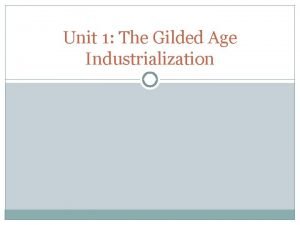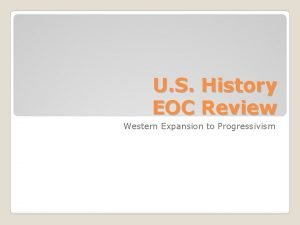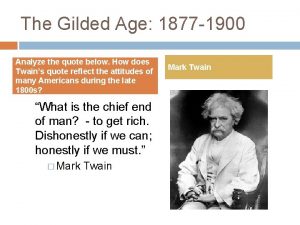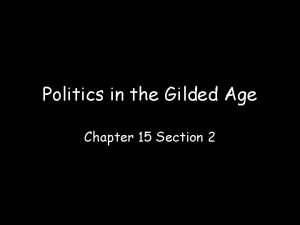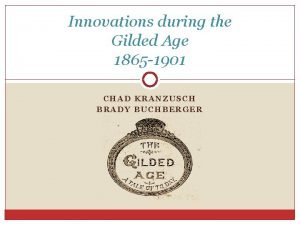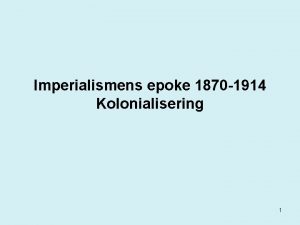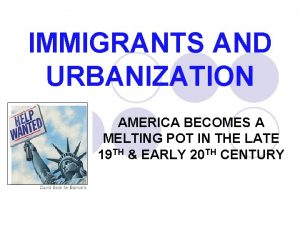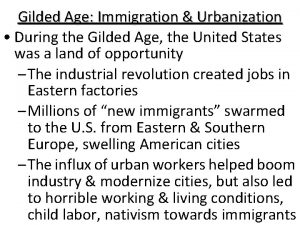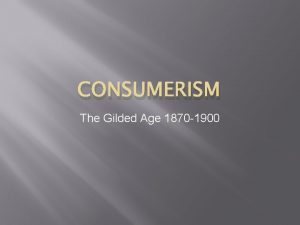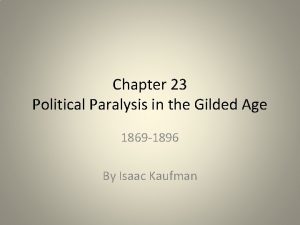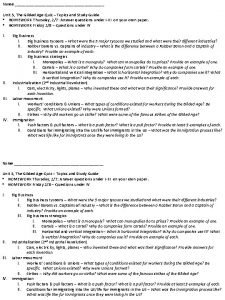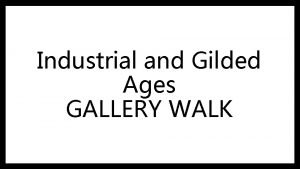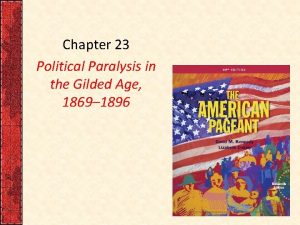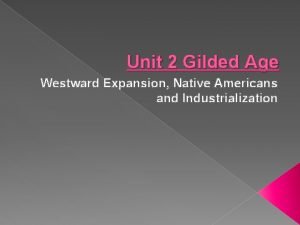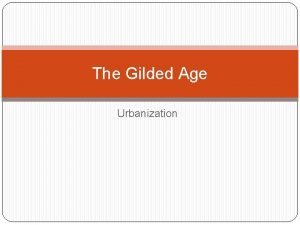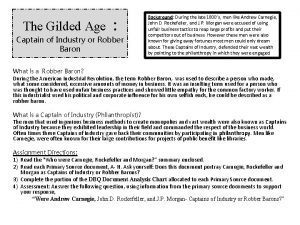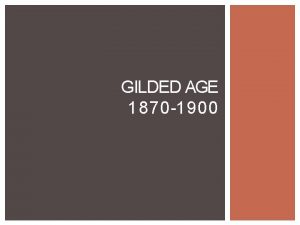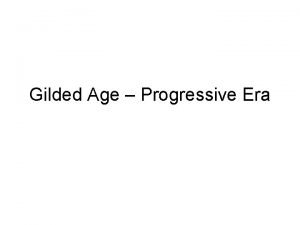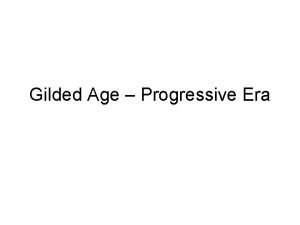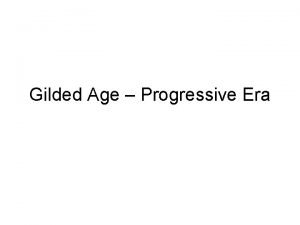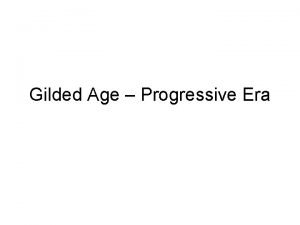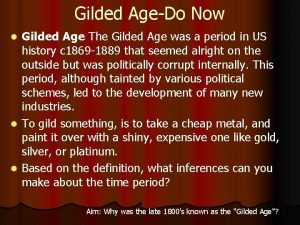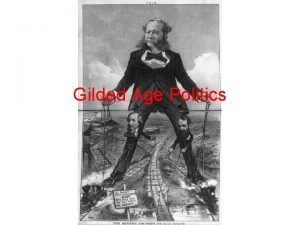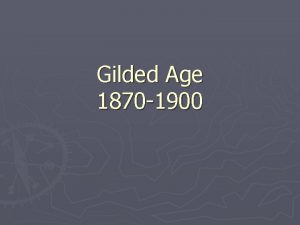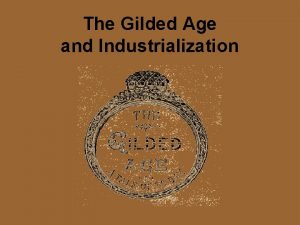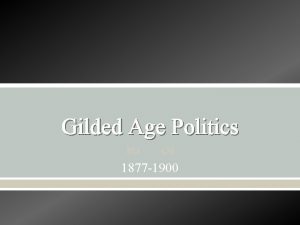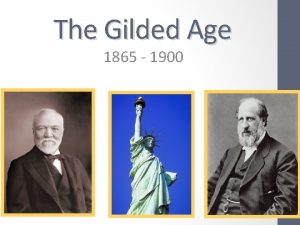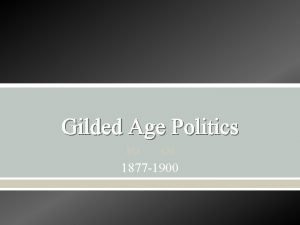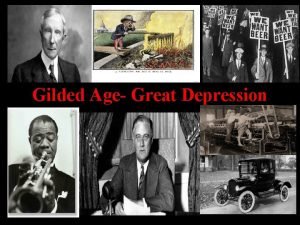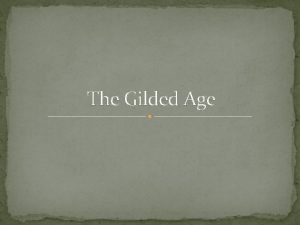LESSON 1 The Gilded Age The Gilded Age























- Slides: 23

LESSON 1 The Gilded Age

The Gilded Age • A time period from the late 1860 s to the early 1900 s characterized by tremendous industrial growth and increasing wealth as well as explosive population growth. • At the same time, the nation experienced corruption in business and government, and workers, farmers, immigrants, African. Americans, women, and children struggled to get by.

The Second Industrial Revolution The Expansion of the Railroads 35, 000 miles of railroad track in the US at end of Civil War in 1865 200, 000 miles of railroad track by 1900 Why was the growth of railroads in South Carolina slow at first? How did railroads fuel economic growth in our state?

The Second Industrial Revolution Engineers and conductors posed for this photograph in Glen Springs. What do you think made upcountry towns attractive to new businesses once railroad service started?

The Second Industrial Revolution The Rise of Big Business • Other factors fueled industrial growth o. Entrepreneurs o. Inventions and innovations o. A large pool of labor

The Second Industrial Revolution The Rise of Big Business • Entrepreneurs (businessmen willing to take risks by investing in and managing new businesses) helped fuel industrial growth. John D. Rockefeller • Wealthy industrialists like Andrew Carnegie and John D. Rockefeller were entrepreneurs in their industries. • Both men created monopolies in their industries. Andrew Carnegie

The Second Industrial Revolution A Large Pool of Labor • For industry to grow, many workers were needed. • Immigrants from other nations helped fill the need. • Between 1800 and 1860, six million immigrants came to America. • 25 million more immigrated to the US between 1865 and 1915.

Many immigrants to the United States came through Ellis Island in New York Harbor. Many came here to escape poverty, disease, and discrimination in their own home country. Why do you think these arriving immigrants are so well dressed?

The Second Industrial Revolution Working Conditions • New machines allowed unskilled labor to make products in large quantities. • Immigrants, blacks, and poor whites usually made up the unskilled labor in factories. • Factory workers had to deal with low wages, long hours, and dangerous working conditions. • Oftentimes, young children and women worked in factories too.

The Second Industrial Revolution Labor Unions • A labor union is an organized group of workers who negotiate with employers for better wages, work hours, job benefits, and safety. • Many unions would lead workers on a strike, where they refused to work until the company met their demands. o 37, 000 strikes between 1881 and 1905 • Companies used different tactics to end strikes and weaken labor unions. What were some things they did?

The Second Industrial Revolution Growth of Labor Unions • Labor unions grew in number after the Civil War. • Several hundred thousand workers belonged to unions by 1872. • There were 32 national unions by then, representing specific trades such as bricklayers, typesetters, and shoemakers. • The National Labor Union was among the first to organize workers. It had more than 600, 000 members, but only lasted 6 years.

The Second Industrial Revolution Growth of Labor Unions • The Knights of Labor remained after the National Labor Union ended. • Union’s slogan: “An injury to one is the concern of all” • How was this union similar to the NLU? • Who was Terrence V. Powderly? • How did Haymarket Square affect the Knights and labor unions overall?

“The Tournament of Today”

The Second Industrial Revolution Samuel Gompers and the AFL • The American Federation of Labor began in 1886. • Like other unions, the AFL sought better wages, hours, and working conditions. • Gompers also wanted a closed shop (a workplace where all workers belonged to the union). • Strikes and boycotts became the AFL’s chief weapons.

The Second Industrial Revolution The “New South” • Describe the “Old South” of the Antebellum period. • What was the economy of the “Old South” based on? • What changes in the southern economy could give birth to a “New South”? • What did Francis Dawson mean when he said: “Bring the cotton mills to the cotton fields”? • How would doing so change South Carolina’s economy?

The Second Industrial Revolution The New South • Southern states began to diversify (to make or offer a greater variety) their economies. o Entrepreneurs help diversify the southern economy by bringing new business to the state o The railroads played a huge role in creating a “New South” as trade became easier What industry saw significant growth in the South?

The Second Industrial Revolution The Textile Boom in South Carolina • How did the textile industry become the symbol of the New South by the early 1900 s? • How did the textile industry affect South Carolina? • How did southern mills compare to those in the North? • What were the features of a mill town? Why do you think these towns were created? • Who benefitted from the creation of mill towns?

Growth of South Carolina ’s Textile Industry

The Second Industrial Revolution New Industries in the South • In addition to manufacturing textiles, other uses for cotton led to new products. Cottonseed oil became an important ingredient in margarine, salad oil, and shortening. • Phosphate deposits discovered in the lowcountry along major rivers led to South Carolina becoming the leading producer of the mineral. • The state’s numerous trees encouraged growth of the lumber, paper, and turpentine industries.

Politics in the Gilded Age • What was the outcome of the 1876 presidential election? • Why was a compromise needed to determine the winner of the election? • What impact did that compromise have on Reconstruction in the South? • How did corruption and dishonesty affect the election of South Carolina’s governor in 1876? Who emerged victorious?

Politics in the Gilded Age Bourbon Rule • Gov. Wade Hampton III and his followers called themselves Bourbons, a name inspired by the French Royal family that had regained power following the French Revolution. • The Bourbons were conservative Democrats who wanted to restore South Carolina to its old glory. • What steps did the Bourbons take to restore the “old order”? • How did Gov. Hampton upset some of his closest allies? What did he do that upset conservatives?

Bourbon Rule Disenfranchising African Americans • Bourbon Democrats passed new laws to defy the 15 th Amendment and prevent blacks from voting. • One law redrew the boundaries of voting districts and decreased the number of polling places, especially in counties with a black majority. • What other actions did Bourbons take to disenfranchise black voters?

Politics in the Gilded Age The National Political Stage • While Democrats ruled in South Carolina and most other Southern states, Republicans ruled the White House and Congress. • Nevertheless, support from Northern cities, Southern states, and former Border States allowed Democrats to remain a strong force in Congress. • Republicans got their strongest support from the West, New England, and northern New York. • Government on all levels was marred by corruption, much of which would be addressed by a reform movement in the early 1900 s.
 The tournament of today
The tournament of today Iron age bronze age stone age timeline
Iron age bronze age stone age timeline Iron age bronze age stone age timeline
Iron age bronze age stone age timeline Entrepreneur gilded age
Entrepreneur gilded age Gilded age eoc blitz review
Gilded age eoc blitz review The gilded age vocabulary
The gilded age vocabulary Gilded age quotes about poverty
Gilded age quotes about poverty The gilded age time period
The gilded age time period Chapter 15 section 3 politics in the gilded age
Chapter 15 section 3 politics in the gilded age Inventions during the gilded age
Inventions during the gilded age The gilded age medvirkende
The gilded age medvirkende Melting pot gilded age
Melting pot gilded age Urbanization during the gilded age
Urbanization during the gilded age Meaning
Meaning Consumerism in the gilded age
Consumerism in the gilded age Chapter 23: political paralysis in the gilded age
Chapter 23: political paralysis in the gilded age Taylorism apush
Taylorism apush Wannamaker's
Wannamaker's The gilded age quiz
The gilded age quiz Gilded age gallery walk
Gilded age gallery walk Chapter 23 political paralysis in the gilded age
Chapter 23 political paralysis in the gilded age Westward expansion acrostic poem
Westward expansion acrostic poem Analyze
Analyze Was jp morgan a captain of industry
Was jp morgan a captain of industry



